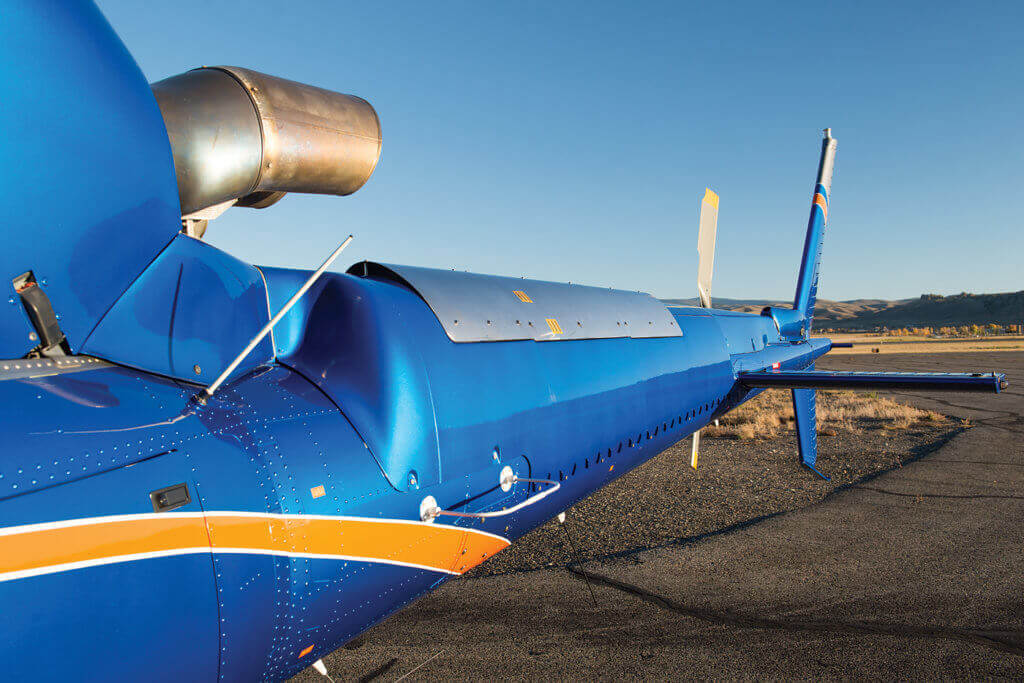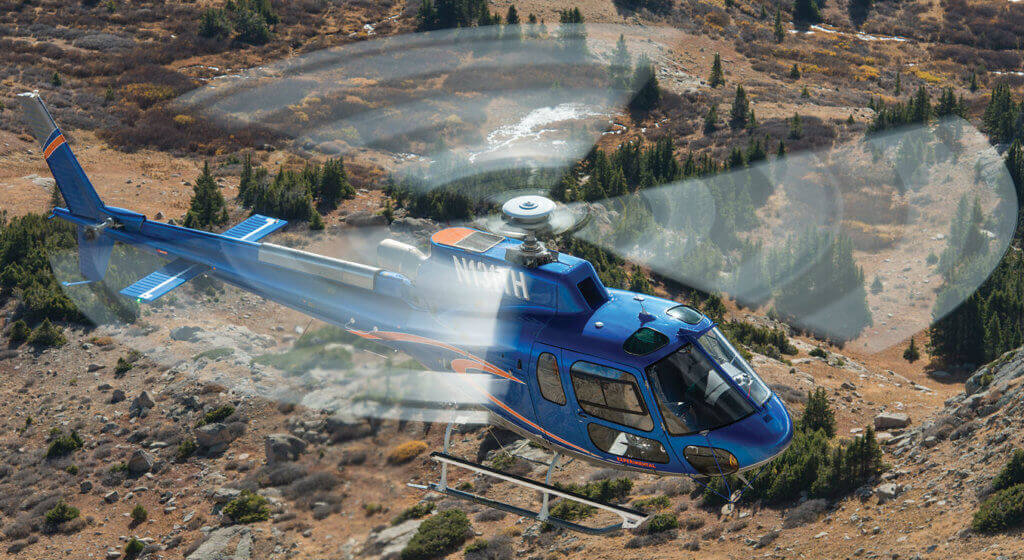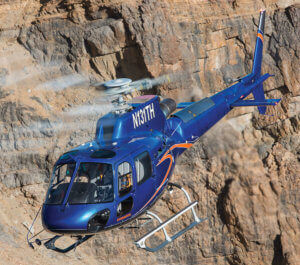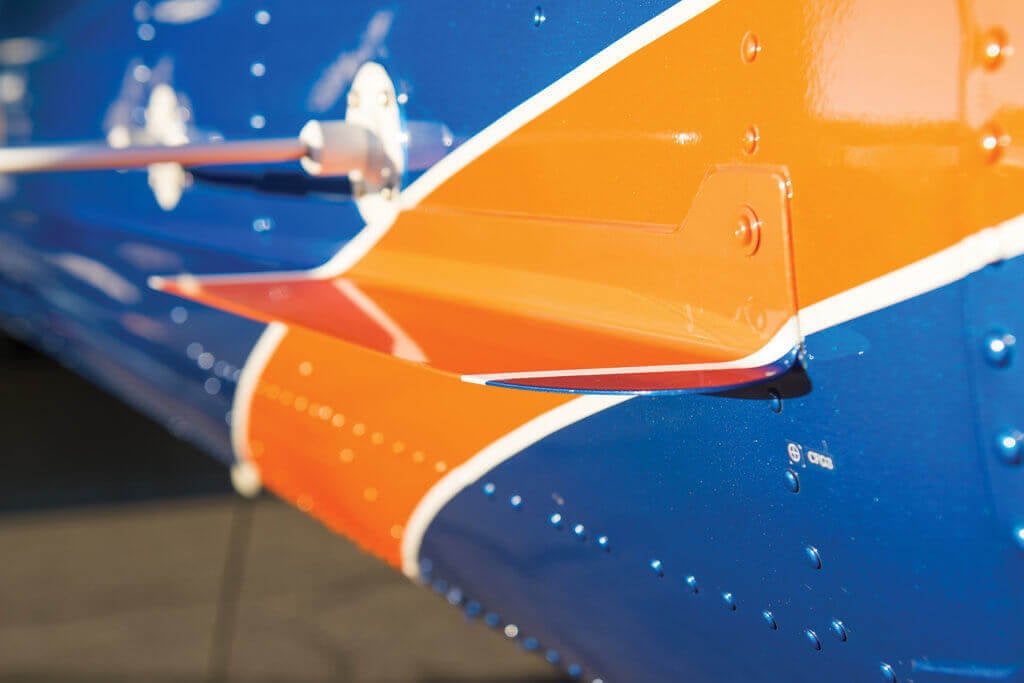Weight is the enemy of flight, and flight is achieved in an aircraft only by compromising desired flight performance as demanded by gravity. Whether in the structure, airfoils, drive system or fuel capacity, all aircraft designs are compromises to some degree dictated by weight.

Most single-main-rotor helicopters rely solely on an engine’s power output to provide both the lifting thrust of the main rotor, and the tail rotor thrust for overcoming main rotor torque and achieving directional control. Although greater performance margins could be achieved by using a larger main rotor and tail rotor, these would require more power and thus a larger engine, which would require a larger fuel supply and a stronger drive train — creating a cycle of increasing weight and diminishing performance returns.
Enter BLR Aerospace, which has a very different approach to improving aircraft performance. Founded in 1991 as Boundary Layer Research, BLR has a long history of developing performance-enhancing aerodynamic modifications for both fixed-wing and rotary-wing aircraft (see p.96, Vertical, Oct-Nov 2014). Rather than increasing power and thereby weight, BLR’s modifications redirect existing airflow more efficiently, taking advantage of “free energy” from the airflow of the main rotor downwash to relieve some of the burden on the engine.
In the rotorcraft industry, BLR is best known for its “FastFin” kits for Bell medium helicopters, which deliver improved hot-and-high performance and tail rotor authority using a tailboom strake and modified vertical fin. Although Bell Helicopter was initially wary of the FastFin system, it proved to be so effective and popular with customers that Bell licensed use of BLR’s supplemental type certificate (STC) for the technology and has made it standard on all new Bell 412EP and EPI helicopters. I have first-hand experience with the FastFin system through my position as chief pilot of Helicopter Express in Atlanta, Georgia, as a number of the Bell 205 A-1s in our firefighting fleet are equipped with BLR’s modifications. So, I’ve long been familiar with what the company’s engineers can offer for those who work on the back side of the power curve.
In addition to 205 A-1s and other Bell models, the Helicopter Express fleet includes a number of Airbus Helicopters H125 (formerly AS350 B3e) and earlier AS350 B3 aircraft. We use these for firefighting, external load work, and short-haul search-and-rescue operations across the western United States, including the Rockies, the Teton and Wind River Ranges of Wyoming, California’s Sierra Crest, and Washington’s Mount Rainier and North Cascades — all very rugged areas that can leave a pilot short on control margin very quickly. Our pilots frequently perform difficult rescues at pressure altitudes up to 14,500 feet and density altitudes as high as 18,000 feet, where any performance advantage counts.

Now, BLR has developed a FastFin system for the H125, which is available as a retrofit kit as well as a factory option for new aircraft. When I was offered the opportunity to fly BLR’s own modified H125 test bed aircraft, I naturally jumped at the chance to see just what enhancements BLR has developed for the “Squirrel,” and how they perform on that airframe from a working perspective.
A Different Kind of ‘FastFin’
For my test flight in mid-September, I traveled to Gunnison, Colorado, where a leased hangar at the Gunnison-Crested Butte Regional Airport served as BLR’s base of operations for the H125 flight test program.
Joining me were BLR president Mike Carpenter and Dan Smith, the company’s director of helicopter programs and experimental test pilot. At the time of my visit, the company was wrapping up a two-year development program that had included over 160 hours of flight testing. All of the company’s baseline unmodified and modified flight test regimes had been completed and the data collected; BLR was waiting on the Federal Aviation Administration (FAA) to schedule the final validation flight tests for the STC approval. (The FAA granted the STC on Dec. 8.)

What I saw on the H125 test bed aircraft in the BLR hangar was not quite what I was expecting. Unlike BLR’s FastFin modifications for Bell medium helicopters — in which a significant amount of sheet metal is surgically removed from the aircraft’s vertical fin — the mods to the H125 are much kinder on the airframe.
All of the original vertical and horizontal fin sheet metal remains intact, as does the tailboom. The tail rotor drive shaft covers are replaced by what BLR describes as an Advanced Tailboom Aerodynamic Cowling, which modifies the left side of the tailboom into an aerodynamic surface that more closely resembles an ideal wing. Vortex generators on the left side of the boom further enhance the lift produced by that side, while a small strake reduces lift on the right side of the tailboom.
An efficient heat shield has been designed into the replacement for the tail rotor drive shaft cover, providing an improved thermal barrier to protect driveshaft bearings during hovering and low-speed flight. Although the test bed aircraft I flew was equipped with a stainless steel heat shield, BLR was planning to replace this with an aluminum version in the production kits. This will save about eight pounds (3.6 kilograms), for a total installed weight of 21 pounds (9.5 kilograms). The added weight of the kit will more than pay for itself, however, as BLR was expecting to certify a net increase in useful load as high as 130 pounds (59.1 kilograms) in hover out-of-ground-effect (OGE). The company estimates that installation of the kit will take about 100 to 120 man-hours.
The test bed aircraft was owned by BLR, which decided to purchase an aircraft outright in order to proceed with the development program more efficiently. According to Carpenter, Airbus Helicopters was very “open-minded and encouraging” when BLR approached them about the project, and was supportive throughout — as evidenced by the fact that the manufacturer is offering the kit as a factory option.

As Carpenter noted, unlike Bell medium helicopters, the H125 does not have a reputation as a tail-rotor-limited aircraft — although it’s certainly known to be a bit “nervous” in an in-ground-effect (IGE) hover, in keeping with its international model name, Écureuil or Squirrel. So, operators may be skeptical of just how much of a difference these modifications make. To find out, I went up in the air with Smith for a 1.5-hour test flight.
No More Jitters
Smith and I tried to get an early start so we could accomplish most of the flight in calm to no-wind conditions, duplicating the FAA’s required flight test environment in which the official data was taken. I also wanted to ensure that I could accurately assess what I felt in the controls in order to compare that to what I was used to.
We began with a pre-flight inspection of the entire aircraft, covering all normal items plus the modifications done for the STC. There wasn’t anything that particularly increased the time or complexity of the inspection, a testament to the no-nonsense design of the kit. Although I was very used to flying our H125s at the density altitudes we would see that morning (around 8,500 feet), I also wanted to give myself a familiar benchmark by flying it at a mission gross weight I knew well. So, after a detailed pre-flight operational briefing and plan of action review, we loaded the aircraft with carefully weighed shot bags and fueled it to reflect my typical mission load and fuel quantity, for a gross weight of around 4,900 to 5,000 pounds (2,220 to 2,265 kilograms).

thus avoiding concerns that it might lead to cracking.
The aircraft was still equipped with the telemetry displays and sensor package it had for the data-gathering test flights, so the cockpit was pretty busy, but Smith showed me where the pertinent information was displayed so we could both refer to it during the flight for reference and comparison. Our flight was also recorded with high-quality video and audio so that anything we noted could be reviewed afterwards.
Start-up and run-up completed, systems checked, telemetry and displays on and working, data link to the hangar verified, communications checked — then Smith let me take the controls for the flight. I slowly came to a skids-light condition and held that for a bit to let things stabilize and get a feel for control responses and deflections. I was making a conscious effort to look at my pedal position while I picked the aircraft up to a hover of around four to five feet. I was anticipating some pedal displacement difference from an unmodified aircraft, I just wasn’t sure how much.
In this IGE hover (four to five feet per Airbus charts) I immediately felt at ease with the handling on all axes; there were no unwelcome surprises. Heading control felt like it was benefiting from a stability augmentation system; some pedal turns in both directions had me noting aloud that the inputs had a smoother, “damped” quality to them, but with no reduction in authority. I hover taxied out to the main runway for a departure to the west and again found myself noting aloud that the typical Squirrel IGE jitters — associated with inconsistent airflow under and around the aircraft — seemed to be much less of a bother, possibly due to the fact that the heading wasn’t being disturbed and the typical unconscious pilot pedal dance wasn’t happening to jar things around.
All Squirrel pilots know how to hover smoothly: they either hover above five feet to get out of the disturbed air, or take the easy way out and do a no-hover departure from lift-off. The latter is a bad habit that has led to some serious accidents when pilots have forgotten to re-energize their tail rotor servo hydraulic power in dual-hydraulic AS350 models (more on that in a bit). Flying the BLR aircraft led me to remark, “It’s like we have training wheels!” Many pilots will appreciate this particular aspect of the kit, since it will inspire confidence to smoothly handle pinnacle, dolly and other technical landings with much less stress.

The takeoff roll was done gradually from an IGE hover down the centerline of the runway for a visual heading reference (we had no wind). Anyone who flies the Squirrel knows to expect a fairly pronounced left pedal input to keep in trim while accelerating through 25 to 35 knots indicated airspeed, due to the increased efficiency of the upper asymmetrical vertical fin. Remember I said I was making a conscious effort to look at my pedal position to see any differences? Well, as we accelerated through translational lift and the airspeed increased, I was surprised at the fact that there was much less of a pedal movement to achieve trim.
I shared this observation with Smith and worked it out as we climbed for pattern altitude. It wasn’t that my trimmed pedal position was any different than it would have been in an unmodified aircraft, it was the fact that I started out from much less of a right (power) pedal position in the hover. Now I realized just how much closer my pedal position in the hover was to the zero-thrust position compared to an unmodified aircraft. Smith and Carpenter had previously told me that the IGE pedal margin improvements were less significant than the OGE margin improvements “due to the slower, less uniform airflow around the tailboom in IGE.” If that was true, and I still noticed the takeoff pedal position difference… I chuckled in anticipation of the maneuvers to come.
Control Margin Where it Counts
Once established in the pattern, I did a normal approach to the centerline followed by a higher power, slower speed profile typical of an external load approach to a spot in the trees — at a fairly steep angle and below translational lift, since there was no wind. Normally in that condition the right pedal would be displaced a good bit, as the tail rotor would be providing all the anti-torque and heading control. Our weight was within the standard hover OGE chart gross weight that guarantees authority in 17 knots relative wind from all directions, so I wasn’t expecting to have a whole lot of right pedal pushed in anyway. However, I was really pleased when the actual amount of right pedal I used for the entire approach to a hover was just a hair past even pedal (with the zero-thrust position being about a half-inch left pedal forward in a correctly rigged aircraft).
I actually felt so confident in the ability to manage heading using induced flow at that point that I talked Smith in to letting me do a load-compensator-assisted hydraulics-off approach to a square helipad south of the runway. (Although nonstandard, training in this procedure is a necessity for my pilots doing human external cargo rescues in the mountains, and we practice it routinely.) I isolated the tail rotor servo with the collective switch while in cruise flight on downwind and felt that familiar pressure on the left foot as we reduced power to shed airspeed for the approach.

Since the load compensator is optimized for assisting a pilot in overcoming the force required to input right pedal for low-to-no-airspeed flight with no hydraulic pressure assistance, the BLR kit doesn’t change the fact you have to push hard on the left pedal in low-power trimmed forward flight. What became apparent to me, though, is how much extra control margin the modified aircraft had when the airspeed dropped well to the backside of the power curve and then to zero airspeed as power was slowly applied. I was actually able to take my feet off of the pedals after pulling OGE hover power in a slow descent to a 10-foot hover. I never needed the assistance of the load compensator to input any right pedal for the hover. The fuel burn had reduced our gross weight, of course, but we were still at an 8,500-foot-plus density altitude!
I held the 10-foot hover over the helipad for 45 seconds or so to feel what it took for any commanded heading changes. Light pressure on the right pedal with load compensator assistance yielded more than adequate control, and easing that pressure back to an even-pedal position held heading with just a slight turn to the left. Left pedal input yielded a highly controllable torque turn due to the fact that the tailboom was still helping provide some anti-torque force. I then executed a near-vertical climb (still below translational lift) to see how much, if any, additional right pedal input I would need to maintain my heading.
After applying enough power to start a 200 to 300 foot-per-minute climb, I initially had to put some pressure on the right pedal. However, as soon as the climb started and the induced flow across the tailboom increased, I took that pressure out to a near-zero-thrust pedal position and safely, controllably climbed out to pattern altitude, where I restored hydraulic pressure assistance to the tail rotor servo. To operators like myself who perform human external cargo work — which requires pilots to carry their people back to safety in the event of a malfunction — this modification makes hydraulic failures in the dual-hydraulic-equipped Squirrel seem like a non-event, even in the most challenging of conditions.
Wrapping Up
Our next order of business was to perform autorotations from altitude in both minimum rate of descent and maximum glide configurations to see whether the modifications that provide such a significant amount of anti-torque force in forward flight are detrimental to left pedal authority in unpowered flight. Not surprisingly, they are not, since the kit is designed to work with main rotor downwash and that airflow is reversed in autorotation. I couldn’t notice any change to the available left pedal authority, even at 80 knots indicated airspeed, where almost all of that pedal authority is used in overcoming the effect of the upper vertical fin.

Smith then demonstrated to me, in experienced test pilot form, the measurable amount of pedal margin available over the baseline unmodified aircraft by flying a straight line down the centerline of the runway in the same fashion as required for FAA testing. The telemetry was displayed on the two monitors in front of the pilot and copilot positions (part of that busy cockpit I mentioned before) and transmitted back to the hangar in real-time. This sequence was first performed in BLR’s aircraft in an unmodified condition to establish baseline data, then repeated in the modified condition in near-identical conditions.
We began our run from an OGE hover of around 40 feet (measured by radar altimeter) in near-zero-wind conditions. Using GPS as a reference for simulated relative wind speed, Smith began to translate 90 degrees sideways down the runway. The display showed me the actual amount of pedal displacement needed to hold heading, as measured by sensors attached to the pedal controls. During the actual test sequences, individual runs representing all the relative wind conditions required for certification were performed. However, I asked Smith to show me only the conditions that most pilots really care about: 90-degree and rear-quartering left and right relative winds.
I wasn’t privy to the unmodified runs, but Smith demonstrated to me a level of heading control that showed a capability above that of the other H125 aircraft I have flown. According to Smith, BLR has proven adequate control margins in relative wind conditions of up to 35 knots in the modified aircraft.
After that demonstration, it was time to head back. I had no doubts about what the BLR team had managed to achieve.

It was clear to me that the FastFin kit for the H125 is a great margin-enhancing device that can also be a production enhancer, if an operator elects to take advantage of the additional fuel or payload that can be carried in hot-and-high conditions. The modifications provide more control margin in high-altitude conditions, and a better comfort margin for critical work. This is in addition to the improved handling qualities that make the aircraft a lot smoother to land and hover. I also see potential for the kit to reduce long-term wear and tear on components by alleviating thrust loading on the tail rotor spider bearing, pitch links and control rod, and also possibly extend the life of the half-shell bearings.
With a list price of US$69,950, the BLR kit isn’t cheap, and some operators may not be able to justify the additional expense. If you fly for one of them, just hope you don’t have a chance to see what you’re missing. My impressions of the aircraft were best summarized in an offhand comment I made to Smith and Carpenter after my flight: “It would really suck to get used to this then have to go back to fly an aircraft without it.”






Very informative report–sounds like a great asset for a working aircraft in any utility application.